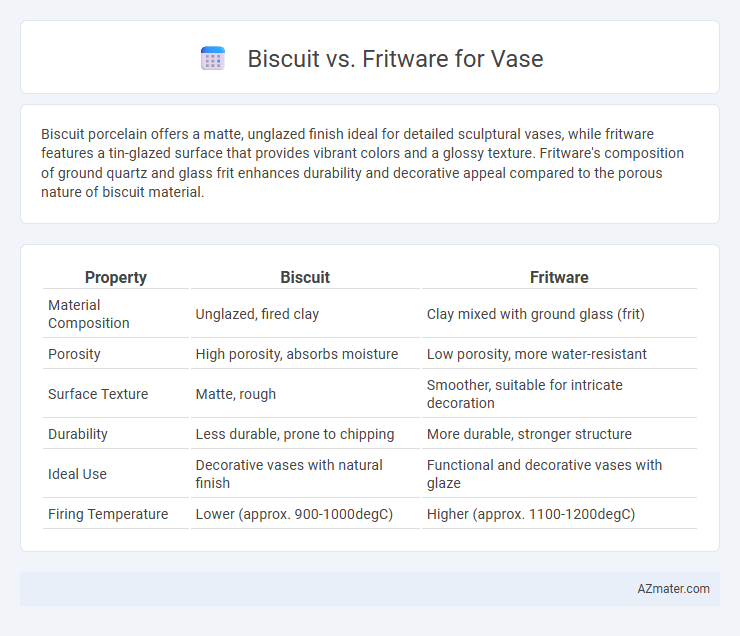Biscuit porcelain offers a matte, unglazed finish ideal for detailed sculptural vases, while fritware features a tin-glazed surface that provides vibrant colors and a glossy texture. Fritware's composition of ground quartz and glass frit enhances durability and decorative appeal compared to the porous nature of biscuit material.
Table of Comparison
| Property | Biscuit | Fritware |
|---|---|---|
| Material Composition | Unglazed, fired clay | Clay mixed with ground glass (frit) |
| Porosity | High porosity, absorbs moisture | Low porosity, more water-resistant |
| Surface Texture | Matte, rough | Smoother, suitable for intricate decoration |
| Durability | Less durable, prone to chipping | More durable, stronger structure |
| Ideal Use | Decorative vases with natural finish | Functional and decorative vases with glaze |
| Firing Temperature | Lower (approx. 900-1000degC) | Higher (approx. 1100-1200degC) |
Introduction: Understanding Biscuit and Fritware
Biscuit and fritware represent two distinct ceramic techniques used in vase production, each offering unique aesthetic and textural qualities. Biscuit refers to unglazed, fired pottery with a matte finish, prized for its porous, natural surface that highlights intricate details. Fritware, composed of ground glass mixed with clay and other materials, results in a smooth, vitrified body known for its durability and intricate decorative potential, often seen in historical Islamic ceramics.
Historical Background of Ceramic Vase Materials
Biscuit porcelain and fritware represent distinct historical techniques used in ceramic vase production, each with unique origins and material compositions. Biscuit porcelain, originating in 18th-century Europe, is characterized by its unglazed, matte finish that highlights fine detailing and sculptural qualities, reflecting advancements in porcelain kiln technology. Fritware, developed in the medieval Islamic world, combines ground glass (frit) with clay to create a durable white body that enabled vibrant glaze decoration, influencing vase craftsmanship across the Mediterranean and beyond.
Definition and Characteristics of Biscuit
Biscuit refers to unglazed, fired ceramic with a matte, porous surface ideal for intricate detail and durability in vase production, allowing for paint or glaze applications later. It features a dense, fine texture resulting from the first firing stage, which makes it sturdy yet porous enough to absorb glazes or paints. Biscuit vases are often used as decorative art pieces or as a base for further artistic enhancement, contrasting with fritware, which incorporates ground glass additives for a smoother, glass-like finish.
Definition and Characteristics of Fritware
Fritware is a type of ceramic material composed of finely ground silica fused with a flux such as soda or potash, creating a glassy, highly durable body often used for decorative vases. Unlike biscuit, which is unglazed pottery fired once to a matte finish, fritware undergoes high-temperature firing that results in a dense, smooth surface ideal for intricate painted designs. The unique composition of fritware allows for a thinner, more refined vessel compared to the porous, rough texture typical of biscuit ceramics.
Production Techniques: Biscuit vs Fritware
Biscuit porcelain is produced by firing unglazed pottery at high temperatures to create a matte, porous surface ideal for detailed sculptural work, whereas fritware involves mixing ground glass (frit) with clay and firing it at lower temperatures to achieve a smooth, durable, and often glossy finish. Biscuit firing eliminates the need for glazing, emphasizing the texture of the raw ceramic body, while fritware's composition allows for vibrant glazes and intricate painted decorations due to its glass content. These distinct production techniques influence the texture, strength, and decorative possibilities of vases made from biscuit porcelain and fritware.
Aesthetic Differences: Texture and Appearance
Biscuit pottery has a matte, unglazed surface that reveals fine clay textures and subtle imperfections, giving vases a raw, natural aesthetic. Fritware offers a smoother, often glossy finish with vibrant colors and intricate designs due to its glassy frit content, enhancing decorative appeal. The tactile contrast between biscuit's porous surface and fritware's polished look significantly influences the visual and textural experience of each vase.
Durability and Functional Properties Compared
Biscuit porcelain, unglazed and fired at high temperatures, offers a matte finish with moderate durability but increased porosity, making it more susceptible to chipping and staining under functional use. Fritware, composed of ground glass mixed with clay and fired at lower temperatures, exhibits higher hardness and improved resistance to water absorption, enhancing its durability and functional reliability for vases exposed to moisture. The vitrification process in fritware contributes to better structural integrity and longevity compared to the more fragile and porous biscuit porcelain.
Artistic Preferences: Which Material for Which Vase?
Biscuit porcelain offers a matte, unglazed finish favored for its smooth texture and subtle elegance, making it ideal for classical or minimalist vases focusing on fine detailing. Fritware, composed of ground quartz fused with glass and clay, provides a more durable, often glazed surface suited for vibrant, decorative vases with intricate painted or inlaid designs. Artistic preferences for vases align with Biscuit for understated refinement and Fritware for colorful, robust artistry.
Conservation and Restoration: Longevity Issues
Biscuit porcelain, known for its unglazed, matte surface, is more prone to surface degradation and staining over time, requiring meticulous conservation techniques to preserve its texture and appearance. Fritware, composed of a glassy frit mixed with clay, exhibits greater durability and resistance to environmental factors, enhancing its longevity in restoration efforts. Restoration specialists prioritize fritware for vase conservation due to its structural integrity and lower susceptibility to moisture damage compared to biscuit porcelain.
Conclusion: Choosing Between Biscuit and Fritware for Vases
Biscuit vases offer a matte, unglazed finish that emphasizes texture and natural clay beauty, ideal for subtle, artistic displays. Fritware vases, made using a glassy frit mixed with clay, provide a smoother, often more colorful and durable surface, perfect for decorative, functional use. Selecting between biscuit and fritware depends on the desired aesthetic--textured simplicity versus vibrant finish--and the intended function of the vase.

Infographic: Biscuit vs Fritware for Vase
 azmater.com
azmater.com